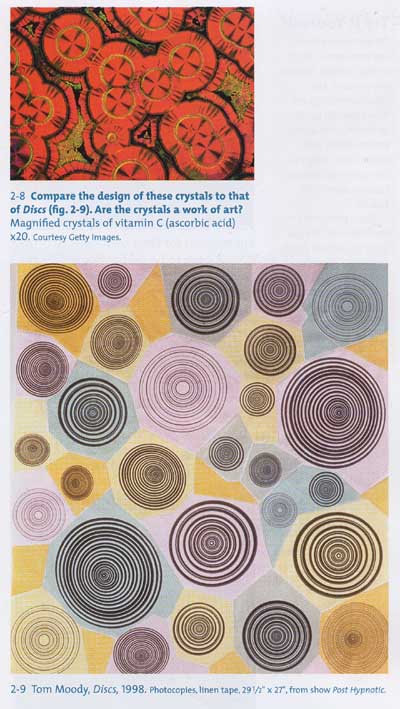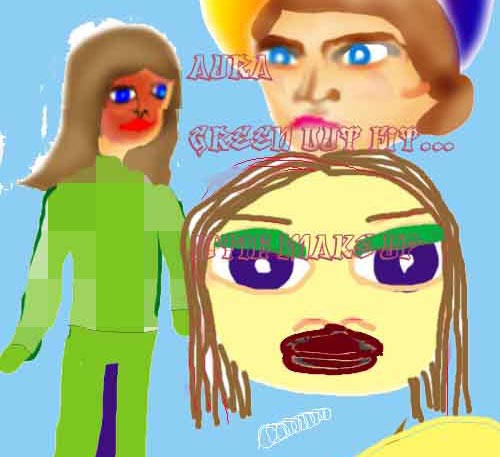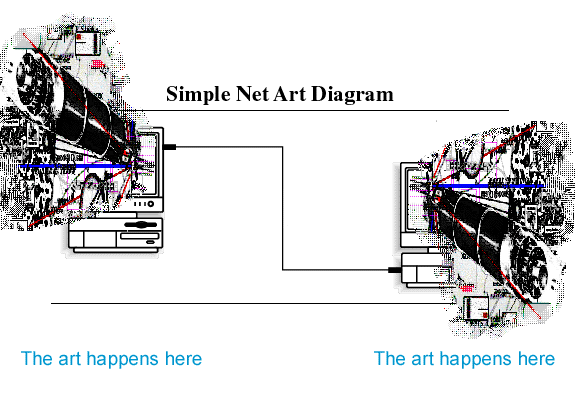View current page
...more recent posts
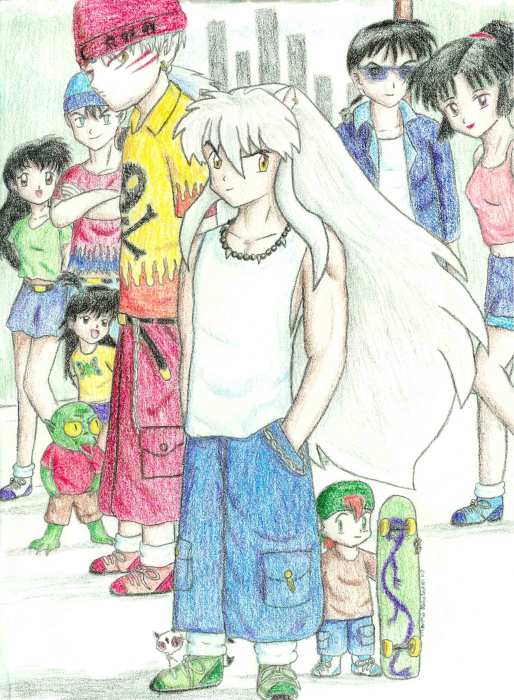
A killer drawing by GoddessOfWinter: the characters of Inuyasha (which I've not seen) in "normal clothes." It's kind of exciting that anime is being embraced by the jr. high and high school set to the obsessive degree that it is. I'd say kids are pretty perceptive in seeking out quality they're not finding in official culture (i.e., Disney pablum). And this is even with Cartoon Network censoring the original Japanese shows. I'd say I wish I was born later so I could experience this otaku-dom directly, but not if it meant going through secondary school again.
Another piece from homeroom gallery in Munich: Martin Wöhrl's Cowboy Door. Wöhrl did a series of saloon doors copied from various Western movies. The found designs varied a lot more than you would think.

One of my favorite anime videos is Castle of Cagliostro, an adventure film about the master thief Lupin III, directed by Hayao Miyazaki 20 years before he did Spirited Away. The narrative pulls you in from the first frame and never lets go. I recently picked up the DVD and heard the Japanese (with English titles) for the first time. I'm always amazed by the differences in the dubbed versions of anime and the subtitled scripts--the American writers take amazing liberties, I guess because it's just low-culture crap for kids and doesn't matter. But the changes can also work for the film. Here are some examples of the yin and yang of dubbing.
About halfway through Lupin is dumped into a catacomb beneath the Castle. It is filled with the skeletons and rotting bodies of people wearing the armor and raiments of all world history, who have sought the secret of Cagliostro and failed. In the dubbed version, Lupin makes typical dumb American small talk as he walks over the bodies ("place could use some fixing up--some plants, new drapes") and then, after he watches a skeleton wearing a jeweled crown crumble to the ground from the chains that have been holding it to the wall, he looks around the killing ground and says:
"Centuries of political murder, and for what? Rest in peace, you poor bastards."That is a great line, and adds a social dimension to what has been pure escapism up to that point. It foreshadows some of the political machinations driving the story that aren't fully revealed until later. And it gives Lupin a depth we haven't seen before now. The subtitled translation in the Japanese version handles the scene very differently. There is no adlibbing--Lupin is completely silent as he surveys the dead. And his assessment and benediction are much more sombre:
"Killing and killing for 400 years. Rest in peace, all of you."This seems truer to the Japanese tradition of honoring the dead but the line isn't nearly as interesting. Another example, this time where the Japanese subtitle is superior: Earlier in the movie Lady Clarisse steals a car and flees the henchmen of the evil Count Cagliostro, to avoid an arranged marriage with the Count. Lupin and his sidekick Jigen intervene to help her, following in their own car. Gunfire is exchanged and the bad guys are dispatched but then Lupin sees Clarisse slumped over the wheel of her still-speeding car. The music clangs dramatically and in the English dub he yells "She's unconscious!"---which sounds like something a paramedic would say and makes you think she might be seriously injured or even dying, clipped by a stray bullet.
In the subtitled version, though, the line is "She's fainted!" Possibly Mary Mason, the American writer, changed it because she thought Clarisse was too strong a character to swoon at the first sign of trouble. Assuming the subtitled line is faithful to the Japanese, that pc rewrite of Miyazaki is presumptuous. Also, for narrative economy and momentum "fainted" is the better choice here: after your initial shock at seeing Clarisse prostrate in the front seat, when you hear (read) that word you know the movie isn't taking a sudden turn for the tragic--you accept that she'll recover if Lupin can only stop the car. (A main character's surprising brush with mortality doesn't occur till much later.) These little examples make you realize how powerful dialogue can be in shaping what you see with your own eyes.
The 3rd edition of The Visual Experience, a secondary school text by Jack Hobbs, Richard Salome, and Ken Vieth, includes a piece of mine, Discs. It's on p. 15, in a section called The Philosophy of Art:
The authors gave me a break in not asking the thornier, implied question: "If the crystals aren't a work of art, why is Discs?" Fortunately the text covers that elsewhere, explaining the history of abstraction, found objects, etc. (The scan is blurry because every way I tried to sharpen it or tweak the contrast it distorted the piece(s).)
Artist Sally McKay is participating in a show in Toronto, opening April 30, called "Robot Landscapes." In her piece, a small mirror-lined box serves as home to a solar powered robot slowly caroming around inside. Reflected on the inner walls of the box is a continuously looped video of a half-factual, half demented Martian landscape; a kind of Zen foil-ball garden with a dozing, skullfaced inhabitant, who may or may not be inflicting intermittent, flaring image breakdown on the Rover's prying digital eyes. The mirror-diorama is viewed through a window, with nearby headphones chiming musical accompaniment--a kind of lo fi, ambio-melodic soundscape created by yours truly. Sally explains more of the particulars here, and she's also offering a scaled-down version of the 9 inch wide video as a streaming or downloadable online video. A borrowed copy of the interface is below.

click for streaming video
(or option click / right click here for download)
graphics by Sally McKay, music by Tom Moody
Saturday night, April 24, a group of laptop performers convened at vertexList, a newish space in the old Four Walls location in Brooklyn. Video artists picked audio artists as collaborators (and vice versa) and the work seemed as random as the pairings: synergy was only intermittently achieved. The video part of the Jeremy Bernstein/Glomag collaboration (coruscating patterns of finely minced abstraction) showed more subtlety than the clunky audio, and the audio part of the jenghizkhan*/Daniel Vatsky union (mysterious, sexily-filtered ambient industrial keyboards) eclipsed the video's rather generic typography-cum-50s-science-textbook imagery. One moment where everything clicked came during the token "analog segment," when Mike Ballou's super-8 film of a crowd pulling a giant helium-inflated pig through the sky found suitable porcine accompaniment in Brian Dewan's morose vacuum tubular oinks.
A cranky comment: some artbloggers outside NY have said "there's nothing going on here" or words to that effect. That's clearly wrong. The scene is so rich, so multi-layered, so overflowing with good work that gallerygoers have become blase--talking, schmoozing, laughing, flirting, and exchanging business cards during performances. The music and video serve only as a cool clublike backdrop for their networking. This is Williamsburg, after all, where those art school "how to survive as an artist" courses are field-tested en masse. To put it bluntly, the pigs weren't just up there on the screen Saturday.
*aka John Parker
CLASSIC RAVE HITS! (except I don't know what any of them are)
All of the following house and breakbeat rave techno tracks were taped off the radio in '93 and '94, specifically during DJ Jeff K's live mix show, "Edge Club," on KDGE-FM in Dallas (besides killing Kennedy, that city has been a haven for club music since the late '80s, as Simon Reynolds noted in his book Generation E). I made them as "studio tapes" (i.e. to play as background music while working on paintings in my studio), but found them indispensable when I moved to NY shortly thereafter and had all my other music in storage. Some tracks were played by Jeff K himself, others by the guest DJs he had on each week (DJ Icy, the Hardkiss collective, Utah Saints (!)). What they all have in common is (1) I still play them on my battered cassettes and (2) I don't know any of the artists or titles, except as noted below. Now that they've been extracted from the longer mixes where they originally appeared--digitally clipped, sutured, & faded in or out as .mp3s--a little attribution help would be greatly appreciated: any information you might have about this weird, E'd-up, often gemlike music.
Techno-Rave
Track 1 [4.5 MB]. "Like this," "come down," and an uncanny "blablablablablablablablablah" are the samples punctuating this frenetic Two Bad Mice-like track. [Update, 2013: finally identified one -- this is a variation of Krome & Time's "Manic Stampede"]
Track 2 [3.4 MB]. The insipid "different strokes for different folks" vocal commencing this number is soon belied by Mentasm stabs and other craziness. The ending sample of a lad saying "only originate and never pirate" (as in "pyrate") cropped up a lot around this time. [Update, June 2021 -- Isotonik - "Different Strokes" (1992) -- hat tip to dj buttstuf on IRC.]
Track 3 [3.7 MB]. Very minimal breakbeat rave recorded on Jeff K's birthday. A sequence of 12 notes is repeated (with the filtering constantly changing) until the middle, when it is replaced by another sequence of 12 notes. [Update, June 2021 -- Psychotropic - "Psychosis" (1990) -- hat tip to dj buttstuf on IRC.]
Track 4 [4 MB]. From a live mix at the Bomb Factory in Deep Ellum, this peppy number (possibly by a Texas producer) merges flawlessly into Joey Beltram's famous "Energy Flash," right before the fade.
House
Track 5 [4.1 MB]. A bouncy little march opens and closes this Dixieland-inflected track. [Update, June 2021 -- L'il Louis - "I'm Hot for You" (Rhythm Method Tribal Mix (1994) -- hat tip to dj buttstuf on IRC.]
Track 6 [5 MB]. Disco-era drum pads, a Chinese prepared piano hook, and a vaguely Middle Eastern diva wail: it's catchier than that sounds.
Track 7 [5.5 MB]. Digs and Woosh of the UK's legendary DIY Crew guest-mixed this deep house track. James at Satellite (who met the DIY-ers in Dallas) thought it was from Chicago, maybe Balance Recordings. The string riff magically smeared dozens of ways sounds like turntablism but I assume it's the sampler. [Update, June 2021 -- Last Session (Ron Trent & Chez Damier) "Sometimes I Feel Like" (Chicago Vox Mix) (1994 -- Blue Cucaracha label) -- hat tip to dj buttstuf on IRC.]
Track 8 [5 MB]. Spare (as in lean) organ riffs from guest DJ Germ-E's mix.
BONUS: Downtempo Rave (?)
Track 9 (5.5 MB). Not sure what else to call this; it's too giddy to be considered triphop. It's from a mix by guest DJ Kid E. [Update, June 2021 -- "Melt City" by Overmow (1992) -- hat tip to dj buttstuf on IRC.]
Animations from the Internet Raytracing Competition are below (each .mpg is around 5MB). How POV Raytracing differs from the stuff Pixar does, or things made with 3D rendering software like Poser or Bryce, I'm not entirely sure. The main feature seems to be how light rays reflect and refract off/through various materials and surfaces, and the folks who make these things are as nerdy as car body fetishists about their various glints and sheens. As for subject matter, the Whitney curators' "quest for the adolescent" could have started and ended here. ("Uh, we meant, a different kind of adolescent...") To cull the rather minimalistic samples below required wading through dozens of one-act plays about muscly aliens and "trips through the wormhole" populated by characters that look like Woody and Buzz. But these are good. The fact that they were done by individuals as opposed to corporate teams weighs heavily in favor of them as a nascent, internet-spawned art form.
Digital Mousetrap Game (the only one with [so-so] sound; the rest are silent)
The End of the Cape Hatteras Lighthouse

Photo by Justine Kurland, from "The Secret World of Girls" ("perhaps the most profound photographic series of this or any other century" --J. Saltz)
Just kidding, the actual attribution is "LiveJournal - artist unknown." Kevin has a good suggested caption in the comments to this post: "Take Your Daughter to Work Day is taken to a tragic but hilarious extreme."
Church of Lo Fi
A friend just jokingly referred to my preference for old computer programs over current software as my "religion." No, religion is believing you have to buy the newest program to make the best art. The opposite of that is...iconoclasm?
But idol-smashing can be dogmatic, too, so maybe it's better to couch the discussion in terms of "desired artistic effects." My old dying Mac SE makes cool sounds from the clipping and distortion that comes from "overdriving" the machine's limited synths, just in normal use--rhythmic patterns of clicks, ominous atmospheric rumbles... You won't get that with garageband (or maybe there's a pallette called "old Mac flaws"? I don't really want to hear about it). Also, there's something about working against limitations, as opposed to having a machine that "does it all for you." Think movie special effects on a budget vs profligate CGI. And finally, there's a certain exoticism of hearing/seeing old tools as they were before years of "improvements." Some of those improvements are engineering tweaks (for speed, etc) but others are simple value judgments the user had no input in. As Dan Graham once said--in so many words, and not necessarily for this reason--the "recently outmoded" can be one of the more fertile and radical places for artists to work.
Anyway, if lo fi is a religion, here's a chapter of the Bible, written by painter Alexander Ross for the "Static" show co-organized by John Pomara and me in '98 (I especially like the bolded para.):
The Recent History of Static in Recorded Music
by Alexander Ross
The static trend in rock music grew initially out of the fuzz guitar sound (best known from the Rolling Stones' "[I Can't Get No] Satisfaction"), which imitated an over-driven or distorting amplifier. Hard-rock outfits continued to push the "guitar wall of sound" well after the '60s, refining it into a subtle and controlled art.
The creative fringe took interest in an accidental by-product of this distortion: the overtones of fuzz, a warm "pink noise" (white noise is static without tone, pink noise is static or "snow" with a hum, or discernible pitch) that rode seemingly independently on top of the music. An early exploration of this might be Eno's "Needle in the Camel's Eye" from 1973, where the constant smashing of guitar chords creates a wall of wavering noise above the song.
A foundational work appeared in the mid-'70s with Lou Reed's controversial and fan-disappointing double LP Metal Machine Music, an all-static-and-feedback statement that figures in rock history much the way Futurist noise performances function in the history of theatre: pure, unequivocal rebellion.
There were some notable static undergrounds coming along in the late '70s/early 80's, namely Chrome (out of San Francisco), and a little later Fi (pronounced "eff eye"). Throbbing Gristle might also be mentioned here, as well as This Heat and Cabaret Voltaire (for example, "No Escape" off their classic first release, Mix-Up). The first group to make the intentional breakthrough into pure static would have to be The Jesus & Mary Chain, who eq-ed the bass-end off the fuzz chords entirely, leaving a shrill, static constant running relentlessly throughout their songs. Next would be Kevin Shields of My Bloody Valentine, where the static becomes more textured and smeared, literally permeating the music. The effect is a sexy, dreamlike blur echoing early '90s trends in fashion photography. Static finally becomes the main subject with the rise of Flying Saucer Attack (Chorus is a good example), out of Virginia, of all places. Here the static is totally frontal, and the music sort of whispers at you through a snowy haze.
The advent of the compact disc in all its sterile flawlessness brought about the realization that technological defects such as tape hiss, amp buzz, record groove ticks, and ultimately the computerized glitches sometimes heard on the CD itself were now interesting sounds never before utilized in conjunction with music. This, combined with the inexpensive home recording boom, coalesced into what became known as LO-FI. Major players, largely confined to the US and New Zealand, include Lou Barlow/Sentridoh, Daniel Johnston, Guided By Voices, and (from New Zealand) post-rockers The Dead C and This Kind of Punishment.
Mid-'90s developments quickly cross-over into the techno-ambient realms with Oval, who boldly dominate the glitch and hiss scene. Mention should be made of Scanner, an individual who scans cell phone conversations and create pieces out of them, with the natural static of the transmission wavering in and out. Most recently is Porter Ricks, also techno-ambient, whose distant discotheque is heard pleasantly through walls of dreamy smush.
The ambient/industrial sector was long-ago onto the static phenomenon, but here there is no music at all, just pure, wonderful noise. Examples here would be The Hafler Trio, Arcane Device, Tibetan Red, PBK, and early Nocturnal Emissions.
Downloadin on the beach or downloadin from TV
Two or a billion sharers, it means nothin to she
Teenagers and grannies is who she likes to do
But then I'm sure you know she's comin' after you.
Her name is R1AA and she sues you for The Man
Just like a river twistin' through a clickin' land...
And when she sues you she does it 'cause she can
Oh R1AA R1AA suin' for The Man.
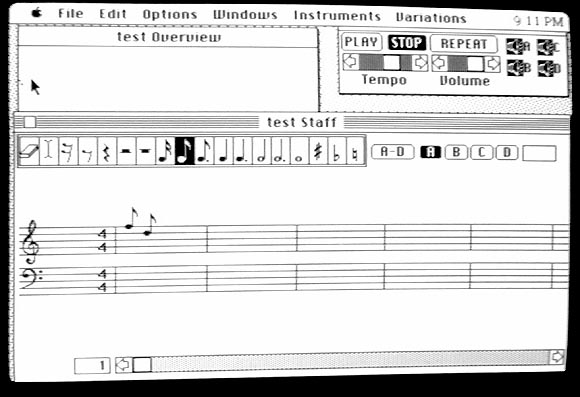
MusicWorks for Macintosh was one of the first music software programs for home consumption (ca 1984); it takes up a whopping 69K of memory. I still use it: it acts as a primitive sequencer, letting me cut and paste loops that I write into some kind of coherent (hopefully catchy) song or composition. It gets a nice, unsophisticated video game sound, with about 10 "instruments"--e.g., piano, organ, trumpet (uggh), chime, synth 1, synth 2--and controls for the attack and decay as well as tremolo and vibrato. The pieces I did in '88, when the computer was relatively new, are more structured (i.e. songlike) than the most recent stuff, which is more "tracklike" and features found sound (other folks' lock grooves from turntables, etc.). A new composition will be posted soon, something I'm pretty happy with--a score for another artist's video--that's more in the '88 spirit.
Unfortunately the ancient Mac SE I run MusicWorks on seems to be dying; it takes longer and longer to save and I've lost some work. I like this little music program a lot--it's sort of the aural equivalent of MSPaintbrush, which I'm also fixated on--and I'm hoping it can be run on the newer Macs. If it can I'll plunk down and buy one.
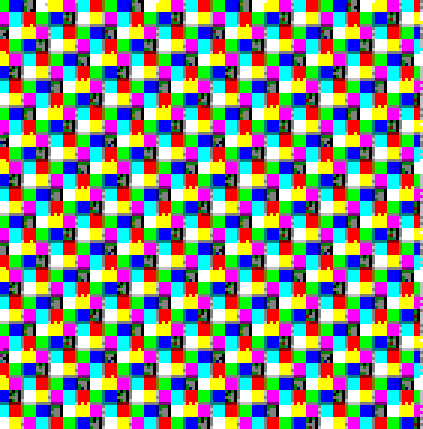
Enlarged detail of animated GIF by Hideki Nakazawa, creator of Digital Nendo.
If you're visiting New York be sure to check out Paper Rad's show at Foxy Production, through May 29. This three-person collective makes video, paintings, drawing, clothing, and artist books with a kind of transcendental, cyberhippie-meets-kid's-show vibe. There are other artists working along similar lines, notably dearraindrop, but 'Rad seems closer to the old Russian constructivist spirit of integrating media and styles into a "unified work": a continuum running from Shockwave sunburst effects to van-style airbrush to simple watercolors to sewn fabric. Think Yellow Submarine, Rubik's cube, mid-90s homepage design, Gary Panter, and for a really obscure reference, the early 70s psychedelic illustration of Bob Brockway and Brad Johannsen. Installationwise, instead of jamming everything into a room (as dearraindrop did), the Foxy show is measured, geometric, and has breathing spaces; the six monitor video stack, featuring contributions by each member in a kinetic, ever-changing repertoire, is exceptional. An earlier video worth seeing is gumby: life is a mister-e: Gumby is too depressed to go on his birthday trip to outer space, so God's arm comes down from a cloud and gently massages away his troubles (and his head). Childlike and disturbing.
Paper Rad: Detail from Weekly Comic.
A couple of cell phone camera pics from the opening by bloggy
Is it possible Jonathan Lethem is a better critic than fiction writer? Motherless Brooklyn aside, his essays on popular culture, especially comics and science fiction, seem more urgent and hilarious to me than his books. I'm thinking specifically of his essays in Bookforum on the secret shame of being a Marvel Comics fan and the sometimes anticlimactic ecstasies of discovering old Philip K. Dick paperbacks in used bookstores ("Vulcan's fucking Hammer! I'd found it! Of course, then I had to go and read the damn thing."). Even in Motherless, some of the highest spots were the little vignettes on pop culture, e.g. Prince ("The way he worried forty five minutes of variations out of a lone musical or verbal phrase is, as far as I know, the nearest thing in art to my condition [Tourette's]") and Mad Magazine's Don Martin ("Mad often held the concluding panel of a Martin cartoon to the following page, and part of the pleasure of his work was never knowing whether the payoff would be a visual pun or verbal riff or merely the sight of a man in a full-body cast falling out of the window into the path of a steamroller."). The following recent thoughts on Marvel Comics in the London Review of Books are also good, despite being framed by rather ordinary juvenile reminiscing:
In Marvel's greatest comics, [writer Stan] Lee and [artist Jack] Kirby were full collaborators who, like Lennon and McCartney, really were more than the sum of their parts, and who derived their greatness from the push and pull of incompatible visions. Kirby always wanted to drag the Four into the Negative Zone - deeper into psychedelic science fiction and existential alienation - while Lee resolutely pulled them back into the morass of human lives, hormonal alienation, teenage dating problems, pregnancy, and unfulfilled longings to be human and normal and loved and not to have the Baxter Building repossessed by the City of New York. Kirby threw at the Four an endless series of ponderous fallen gods or whole tribes and races of alienated antiheroes with problems no mortal could credibly contemplate. Lee made certain the Four were always answerable to the female priorities of Sue Storm - the Invisible Girl, Reed Richards's wife and famously 'the weakest member of the Fantastic Four'. She wanted a home for their boy Franklin, she wanted Reed to stay out of the Negative Zone, and she was willing to quit the Four and quit the marriage to stand up for what she believed.After reading this careful, historically accurate exegesis I'm still mystified why Lethem flubbed some of the references in Fortress of Solitude (see earlier post). Let's save for another time why reading about our (I mean, my) pop-cultural past strikes a deeper chord than revisiting the day to day agony and boredom of 7th and 8th grade. (hat tip to Travelers Diagram for spotting Maud Newton's spotting of the essay)I seriously doubt whether any 1970s Marvel-loving boy ever had a sexual fantasy about Sue Storm. We had Valkyrie, Red Sonja, the Cat, Ms Marvel, Jean Grey, Mantis and innumerable others available for that. We (I mean, I) especially liked the Cat. Sue Storm was truly invisible. She was a parent, a mom calling you home from where you played in the street, telling you it was time to brush your teeth. Not that she wasn't a hottie, but Kirby exalted her beauty in family-album style headshots, and glimpses of her, nobly pregnant, in a housedress that covered her clavicle. The writers and artists who took over The Fantastic Four after Kirby and, later, Lee departed the series, seemed impatient with the squareness of Sue and Reed's domestic situations. Surely, these weren't the hippest of the Kirby/Lee creations. Nevertheless, if you (I mean, I) accept my premise that the mid-to-late 1960s Fantastic Four were the exemplary specimens, the Revolver and Rubber Soul and White Album of comics, and if you further grant that pulling against the tide of all of Kirby's inhuman galactacism, that whole army of aliens and gods, was one single character, our squeaky little Sue, then I wonder: Invisible Girl, the most important superhero of the Silver Age of comics?
Paul Berman, a so-called "liberal hawk," is back on the New York Times op-ed page today selling his particular brand of snake oil (annotated version here). You'd think this ideologue, whose left-leaning pro-war views were often sought out by editorial page editors in the run-up to the invasion to balance...well, all the right-leaning pro-war views, might be hanging his head in embarrassment at the current debacle. But no, he urges us to stay the course to combat his particular bugbear, Islamofascism. Based on his scholarly "discovery" of a sort of Islamic Mein Kampf written by an obscure theologian named Sayyid Qutb, Berman believes that all the diverse Muslim peoples (Arabs, Persians, Pakistanis) can be--are being--united by a paranoid millenarian philosophy that will eventually overcome all sectarian, nationalistic differences and cause Mohammed's followers to goose-step as one. So powerful is this "death-loving" cult that it even includes secular states such as (the former) Baathist Iraq.
By inventing a Unified Menace to replace the Soviet Union in the popular imagination Berman was helping, prior to the invasion, to do the intellectual heavy lifting for a belligerent and not-so-brainy Administration; now his role is to develop the fallback position after our failure to find WMDs. Which is: although Saddam wasn't involved with 9/11 (and wasn't an Islamist) he contributed to the Islamofascist "atmosphere" that made the attacks possible. Just so it's clear: we went to war and have lost almost 700 soldiers and killed 10,000 Iraqis because of the "atmosphere" emanating from the country. In his polemic for imposing liberal democracy by force, Berman never gives a hint that Muslims might reasonably fear people who offhandedly refer to actions in Islamic countries as "crusades" or have a military presence spanning such territories called "the footprint." Or who abet the taking of Muslim land by signing off on egregious policies of settlement, wall building, and "annexation" in the West Bank.
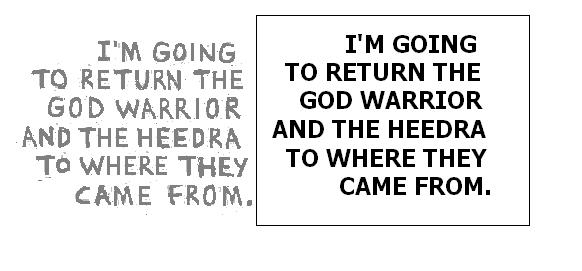
several more new drawings here (click thumbs for enlarged versions).
My Complete Musical Works in MP3 Form
1998 - present
1. Scratch Ambulance [3.75MB]
2. Phil's Revenge (TM vs Ectomorph) [2.65MB]
3. Brakin' 1 [1.86MB]
4. Brakin' 2 [2.03MB]
5. Calypsum (TM vs M. Mayer) [3.27MB]
6. Migrant Song [2.29MB]
7. Streetsong (TM vs 8BCS) [2.84MB]
8. Eins Zwei Drei [1.37MB]
9. Eins Zwei Drei (Melody) [1.05MB]
10. Monster Scales [1.25MB]
11. Robot Landscape [3.5MB]
1988
1. Arpeggiasm [1.76MB]
2. Dance of the Nematodes [2.18MB]
3. Lament for a Treefrog [1.22MB]
4. Life in the Mortuary [0.75MB]
5. Pass the Amphetamines [1.03MB]
6. Spring Has Sprang [0.83MB]
7. The Organist Died [0.59MB]
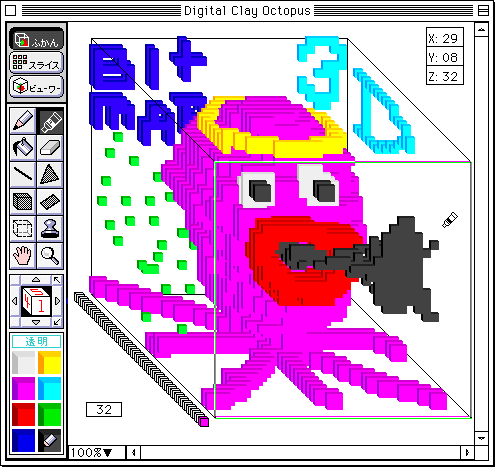
Digital Nendo (Digital Clay) - 3D Bitmap program from '97 by Hideki Nakazawa. Be sure to check out the animated screen shots. I haven't downloaded the program--the Japanese online store is a bit daunting to this lazy American surfer--but would be interested in seeing any gifs made with it. That "octopus ink" is awe-inspiring. [via]
Notes on the 2004 Whitney Biennial
1. If you like work made with a jigsaw, painted, and stuck at right angles to the wall, this is your Biennial.
2. Started on the 2nd floor and worked up to 4. "Is this the fey, twee Biennial or just the fey, twee floor?" ("Fey": everything from Banks Violette's black, stalagmite-infested drumkit to Elizabeth Peyton's pale, perpetually red-lipped popstars; "twee": the preponderance of little craftsy cut out-y things in the show. Sensitive boys meet sensitive girls and ignore each other for their respective playworlds.)
3. Stood gaping at Assume Vivid Astro Focus' busy, businesslike post-psychedelic installation for a long time and finally said, though gritted teeth, "I don't like this."
4. Bad painting, and not in a good way: Mel Bochner's happy, colorful "word art" channelling Jessica Diamond, Kay Rosen, et al. Laura Owens' fake-zany, fake-clumsy giant tree with birds, etc.: uggh. Cameron Martin: boring!
6. Too many installations!
7. Wanted, for curatorial malpractice: Shamim Monin, Chrissie Iles, Debra Singer. Crime: Placing Cory Arcangel/BEIGE Nintendo clouds piece next to brilliantly lit mirrored room, washing out the lower right corner of the video projection. If they did this to a Barnett Newman they'd have old men with cigarettes hanging off their lower lips and romantic stubble sending them critical letters the rest of their lives.
8. Too clever by half: Golan Levin's interactive piece on the popularity of numbers. Does "3" beat "89908" for the most uses out there in the world? And what are those uses? Scroll and see! If this is a satire of the computer nerd's relentless drive to quantify everything, it's pretty good; if it's a celebration of that same tendency it's the world's most elaborate executive toy.
9. Having said all this mean stuff, the show was still fun: better cumulatively than object by object. Even mass infantile regression beats Larry Rinder's earnest, tedious 2002 effort. It helped seeing it with a large audience of toddlers, teens and bus-tour seniors: through their eyes, it was an adventure. If only that sense of awe & enthusiasm could be piped into Chelsea's dreary classist environment.
10. Best of show: the films and videos. Sue de Beer's two-channel piece, discussed here earlier, works even better in a small room than it did in Postmasters' big cube. It was great to see the Jack Goldstein loop, an undersea travelogue missing only a Film Board of Canada soundtrack and boomy male voice saying "When lava pours out of the sea mount, islands are formed..." For positive things about these and other artists, please see Sally McKay's report.
UPDATE: Here's one explanation for all the "youthful exuberance." I'm told that in setting up studio visits outside NY, the curators asked to see "young artists." That sounds like pimp talk. Hypothetical local museum director: "Are you looking for someone good?" "No, we're looking for someone young."

Ralf Hutter of Kraftwerk. The second most influential pop group after the Beatles is touring in support of Tour de France Soundtracks, their first CD of new material in 18 years. While not as aggressive, funky, or strange as their earlier work, it's good: kind of shimmery and ambient and yes, they can still write hooks. "Vitamin," "La Forme" and the remixed 80s hiphop classic "Tour De France" are quite hummable. They sound as if they spent all those years tracking down every trace of hiss and hum in their studio and then carefully mastered every millisecond because it's an amazingly clean, refined production. One thing they still have over the generation of electronic dance musicians they inspired is great technical finesse, and I'm guessing machines expensive enough to produce sounds and textures beyond the budgets of most basement producers. They don't flaunt it, though; the music is very understated. More tour photos in addition to the ones above, by Swedish photographer Henrik Larrson, are here. A review of the Brixton Academy show is here. |



Proposal for Abstract Expressionist Wall Projection (Party at Bill Gates')
"Knowledge Transfer"=Train Your Indian Replacement
Here's a sickening story, from USA Today, explaining how job outsourcing works. You get a pink slip, and are offered one more paycheck and some increased severance if you will train your replacement. A new employee, who will be working for about one-fifteenth of your pay, is flown over from India or China for a few weeks, and you get to teach him or her how to do your job. This is called "knowledge transfer."
UPDATE: I removed my angry comment about this story because it didn't make me feel any better. Suffice it to say, labor issues are growing steadily worse as society becomes more mobile and faceless. You cant picket the big factory on the hill because nobody knows precisely where the owners are anymore. And by having security guards escort you out when you're laid off, employers never see your face or feel any consequences of their actions.
UPDATE: See the comment to this post for more on the mechanics of "knowledge transfer."
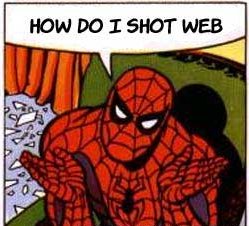
From Aaron in Japan, the website of a Japanese-speaking Canadian working for Hitachi in Yokohama. Many affectionate bad english quotes, a Dance Dance Revolution page, photos. Almost as good as traveling there.
Just a few more thoughts on this Net Art thing (hey, someone has to do this, if the Times won't).
1. Early Net Art was made by software writers who knew their way around the enabling programs, hence the prevalence of flow charts, clickable steps, etc built into the art. Now, more artists are just working with the tools (image-making, sound-making software) and using the Net as a delivery system. This newer work is less about commenting on, reproducing or "deconstructing" the tools, or the Net itself--although those concerns do (and should) linger, since proprietary programs are controlling and kind of evil.
2. Early Net Art was made in a era of limited bandwidth, hence all the ASCII drawings and text-based art.
3. Bandwidth-hogging current Art on the Net (as opposed to Net Art) is aimed at an "elite net" of broadband users.
4. For a few examples of non/anti/post Net Art please see the links column to the left and my revised BitStreams roster.

Lt. Col. Nate "Heavy Dose of Fear and Violence" Sassaman is back in the news this week. His men allegedly forced some Iraqi curfew violators to jump off a bridge into the Tigris (wearing flex cuffs, apparently), and one of the Iraqis allegedly never came out of the water. Oh yeah, and then Sassaman allegedly covered it up.
But otherwise, things are going well over in Iraq. Looks we'll have a nice orderly transition of power to the new government (Ahmed Chalabi) come June, and then we can all pat ourselves on the back for a job well done. Sure, there are a few problem regions and an "outlaw cleric" to be dealt with, but overall, the Bush team--and especially the "brain" Dick Cheney--has done a superlative job on this thing.
Below is my own reconfiguration of the "MTAA simple" and "Linkoln complex" net art diagrams, a stab at representing graphically the point I was trying to make in a (somewhat rewritten) previous post. File this under art criticism (or trainspotting), not art.

There has been a little controversy in bloggerville over the American mercenaries killed by the mob in Fallujah. Kos, who posts on the liberal website Daily Kos, made a supposedly ill-advised remark in some other blogger's comment section about the deaths, leading right wing law professor Glenn Reynolds (aka Instapundit) to recommend boycotting or censuring Kos's sponsors, many of whom were Democratic candidates. A few advertisers pulled out (don't know if any--or how many--were candidates), but Kos says he's replaced them. Predictably, the unctuous Kerry campaign publically de-linked Kos from its website.
Here's what Kos said about what he said:
There's been much ado about my indifference to the Mercenary deaths in Fallujah a couple days ago. I wrote in some diary comments somewhere that "I felt nothing" and "screw them."Those deaths were terrible but I hate that saying "screw the mercenaries" is being framed as an issue of patriotism or "supporting the troops." These high-paid soldiers of fortune are essentially a private army dedicated to securing Middle East oil assets and protecting corporate interests abroad. And just a reminder: they're shooting Iraqis today; tomorrow they could be over here in the States breaking strikes and busting protesters' heads. This isn't as farfetched as it sounds: the Bush campaign recently hired Vance International, notorious anti-labor thugs, for "private security." This privatization of military functions is a sick trend, and I actually think it's more patriotic to oppose it. Unfortunately the Kerry campaign seems to think we should "support the mercs."My language was harsh, and, in reality, not true. Fact is, I did feel something. That's why I was so angry.
I was angry that five soldiers -- the real heroes in my mind -- were killed the same day and got far lower billing in the newscasts. I was angry that 51 American soldiers paid the ultimate price for Bush's folly in Iraq in March alone. I was angry that these mercenaries make more in a day than our brave men and women in uniform make in an entire month. I was angry that the US is funding private armies, paying them $30,000 per soldier, per month, while the Bush administration tries to cut our soldiers' hazard pay. I was angry that these mercenaries would leave their wives and children behind to enter a war zone on their own violition.
So I struck back.
[...]
[In] Iraq, our men and women in uniform are there under orders, trying to make the best of an impossible situation. The war is not their fault, and I will always defend their honor and bravery to the end of my days. But the mercenary is a whole different deal. They willingly enter a war zone, and do so because of the paycheck. They're not there for humanitarian reasons (I doubt they'd donate half their paycheck to the Red Cross or whatever). They're there because the money is DAMN good. They answer to no one except their CEO. They are dangerous, hence international efforts (however fruitless they may be) to ban their use.
So not only was I wrong to say I felt nothing over their deaths, I was lying. I felt way too much. Nobody deserves to die. But in the greater scheme of things, there are a lot of greater tragedies going on in Iraq (51 last month, plus countless civilians and Iraqi police). That those tragedies are essentially ignored these days is, ultimately, the greatest tragedy of all.
We're continuing to discuss that dumb New York Times article about Net Art here. There has been a sea change that the writer completely missed--an influx of artists redefining the medium, not so much through browser-dismantling code a la Jodi.org, but testing the limits of how much a window can hold, like turning an amplifier up to 11. These largely basement producers handle Net graphics in a painterly or expressionistic way, cocking a half-appreciative, half-horrified eye on all the weird content out there on the Internet. The phenomenon isn't about marketing (yet) but rather thrives within the Net's potlatch or "gift economy" of upload exchange. Artists put up simple animations made with .GIFs or Flash, with sound or without, as well as appropriate, resize and mutate found .GIFs and jpegs, attacking visual phenomena the way a junglist attacks sound (to make an electronic music analogy). Rebellious defacement and smartass humor trump the tedious academic-cum-Sol LeWittoid pallette of earlier net practice. In the Times thread Sally sums up the first generation of self-defined Net Art as "long-loading, find-the-place-to-click-me narratives packed with theoretically correct reference to the body or lack thereof." There are just too many sites resembling university sociology projects, rarely repaying the time you invest in them, illustrated with diagrams like this one from 1997:
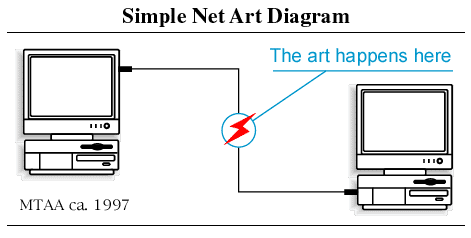 .
.
It's not that MTAA is humorless, but their art is very much about pointing and clicking and following steps, rather than just having raw sensation flooding into your browser. For an example of the latter, check out this remix of the above diagram by Abe Linkoln, one of the bloggers at 544x378(WebTV). Talk about the Oedipal slaying of a forerunner. Here's another piece from the WebTV site (I think also by Linkoln). This was done by searching "544 X 378" in Google Images, picking a blurry, faintly appalling image out of a page full of possibilities (in this case a random dork in a mask sitting at his computer), then adding a kind of Sigmar Polke screen of "plus" signs as a shifting psychedelic overlay. This use of dimensions to search for images has the randomness of a drive-by shooting. Or check out this .GIF by jimpunk, an image both sublime and gritty, resembling a sleek physics demo that appears to be destroying its own background:
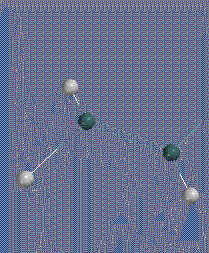
With more of this happening, the Whitney might think about setting up those terminals again!
UPDATE: My own reconfiguration of the "MTAA simple" and "Linkoln complex" net art diagrams is here.
UPDATE, 2012: The GIF I thought was posted by Linkoln was, in fact, posted by Linkoln (then called Abe W. Linkoln), on March 15, 2004 (permalink to the post doesn't work).
A couple of short clips from Laura Parnes' video installation Hollywood Inferno are now available on her website. As I mentioned in an earlier post, some of the dialogue is appropriated, Kathy Acker-style, from media and art-critical sources. In this clip (which should load in your browser as a Quicktime movie), the source of the words is Dave Hickey, a critic embraced as a spiritual mentor by many of my peers for his supposedly frank, "jazzy" style. Some see him as a noble outsider, I think, when he is in fact a creature of the institutional art world, and quite the cynic. As a non-fan from way back, I get a special kick hearing his words spoken by Guy Richards Smit's sleazebag Virgil, who, in Parnes' video, is a Satan figure leading a young girl inexorably to damnation. As Lisa Gangitano puts it, somewhat less ecclesiastically, in her "Repulsion" exhibition catalog essay:
Sandy occupies hermetic spaces that Virgil is quite eager to fracture, providing viewpoints previously unavailable to [her]. As he leads her through this defamiliarized territory populated by demonic Furbies, Columbine models, and fire-breathing teenagers, she becomes more and more seduced by the pleasure of spectatorship. The scale of her world shifts, and so does her definition of beauty.Hickey, however, reverses the process, leading the reader back to comfortably familiar notions of beauty from the wilderness staked out by "French critics."
This page from the English department of a Japanese university strings together excerpts from science fiction novels and stories into a continuous single text. It reminds me of THE NAM, a phone-book thick transcription of dialogue from five Hollywood Vietnam movies by YBA (young British artist) Fiona Banner. The only two chunks of text I recognize are Heinlein's Stranger in a Strange Land and Cordwainer Smith's "A Planet Called Shayol" (any other attributions?). I wrote about the Smith story a while back and have cleaned up the excerpt from the Japanese page and posted it in the comments to that post. That is one f*ed up story.
The NY Times ran another in its endless series of chin-scratchers on "Internet Art" yesterday. The writer talked to a few of the players but couldn't reach any conclusions, so he opted for the annoying "on the one hand/on the other hand" format, while still trying to make it sound like some Rubicon had been crossed. Or retreated from. Or something. He mentions one noteworthy fact as evidence of the "death of Net Art"--that the Whitney included no internet section in the Biennial this year--but then doesn't talk to the current Biennial curators to ask why that decision was made. (Maybe it's just because the terminals never worked.) Instead, he tracks down the curator of the 2002 Biennial and gets some exquisite hot air on the subject.
Below is an annotated version of the article.
March 31, 2004
DIGITAL
Internet Art Survives, but the Boom Is Over
By BEN SISARIO
IT'S dead. It's thriving. It's everywhere and nowhere.
Like most things in the online world, the state of Internet art is subject to no small amount of exaggeration. During boom times, as art made with ones and zeroes entered Chelsea galleries [Postmasters] and blue-chip museums, the new form was seen as the wave of the future [by reporters and publicists]. But now, ask an artist or a gallery owner or a blogger about it and you are likely to get a groan [; ask an artist about it and you're likely to hear that no one calls it Net Art anymore; ask a blogger about it and he will mention a hundred wack things he's found lacking any institutional imprimatur.]
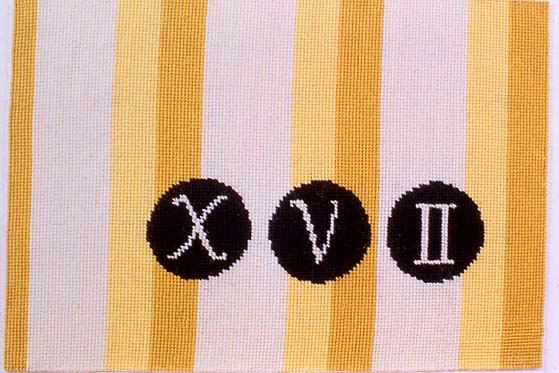
Bill Davenport, XVII, 1994, wool needlepoint (stitched by Olga Vannucci). My earlier discussion of Davenport is here, and more needlepoints from the series are here (click on thumbnails for enlarged views).
cuechamp recently posted a music mix titled "source code" [(76 min - 72MB - .mp3], consisting of the original songs--mostly from the '70s--that were subsequently, heavily mined for sampled drum breaks by hiphop and drum & bass producers. If you've listened to any music other than country (and maybe even that) for the last 25 years you will also recognize many of the piano stabs, vocal hooks, and random cowbells in these R&B, funk, and fusion classics (they were also very popular with house and garage producers). cuechamp doesn't layer or mash up the tunes: one song respectfully follows another in a nice flow that would also make it an excellent house party soundtrack. Here's the tracklist:
1. chase the devil - max romeo and the upsetters
2. amen, brother - the winstons
3. think about it - lyn collins
4. apache - incredible bongo band
5. ready or not - the delfonics
6. take me to the mardi gras - bob james
7. i'm gonna love you just a little more - barry white
8. shack up - banbarra
9. you can't hide from yourself - teddy pendergrass
10. scorpio - dennis coffey
11. fate - chaka khan
12. dance to the drummer's beat - herman kelly (I love this one -tm)
13. all this love that i'm giving - gwen mccrae
14. get out of my life woman - lee dorsey
15. far beyond - locksmith
16. ashley's roachclip - soulsearchers
17. i love you more - george duke
18. champ - the mohawks
19. praise you - camille yarbrough
20. funky drummer - james brown
It would be interesting to create graphs showing all the subsequent uses of sound bites from this "source code." If you sorted them by length you'd probably find the samples get longer in proportion to (1) the age of the track using the sample and/or (2) the economic strength of the samplee. This is because of an "invisible attractor" force in current creative endeavors called The Law. Early house and hiphop was made in the day before humorless poor sports like The Turtles started suing and winning cases for their precious string snippets. Nowadays the samplee becomes an involuntary creative partner in the new production, depending on the amount of lawyer fees he/she can afford (or recoup on contingency). Such issues are discussed in Lawrence Lessig's new freeware book, also linked to on cuechamp's page.
Here's a relevant quote pulled not from Lessig's .PDF but from a NY Times article about the Danger Mouse Grey Tuesday protest, before the article disappeared into the Times' proprietary vault:
Jonathan Zittrain, a director of the Berkman Center for Internet and Society at Harvard Law School, said the issue is indeed a gray one. "As a matter of pure legal doctrine, the...protest is breaking the law, end of story," Mr. Zittrain said. "But copyright law was written with a particular form of industry in mind. The flourishing of information technology gives amateurs and home-recording artists powerful tools to build and share interesting, transformative, and socially valuable art drawn from pieces of popular culture. There's no place to plug such an important cultural sea change into the current legal regime." (emphasis added)

